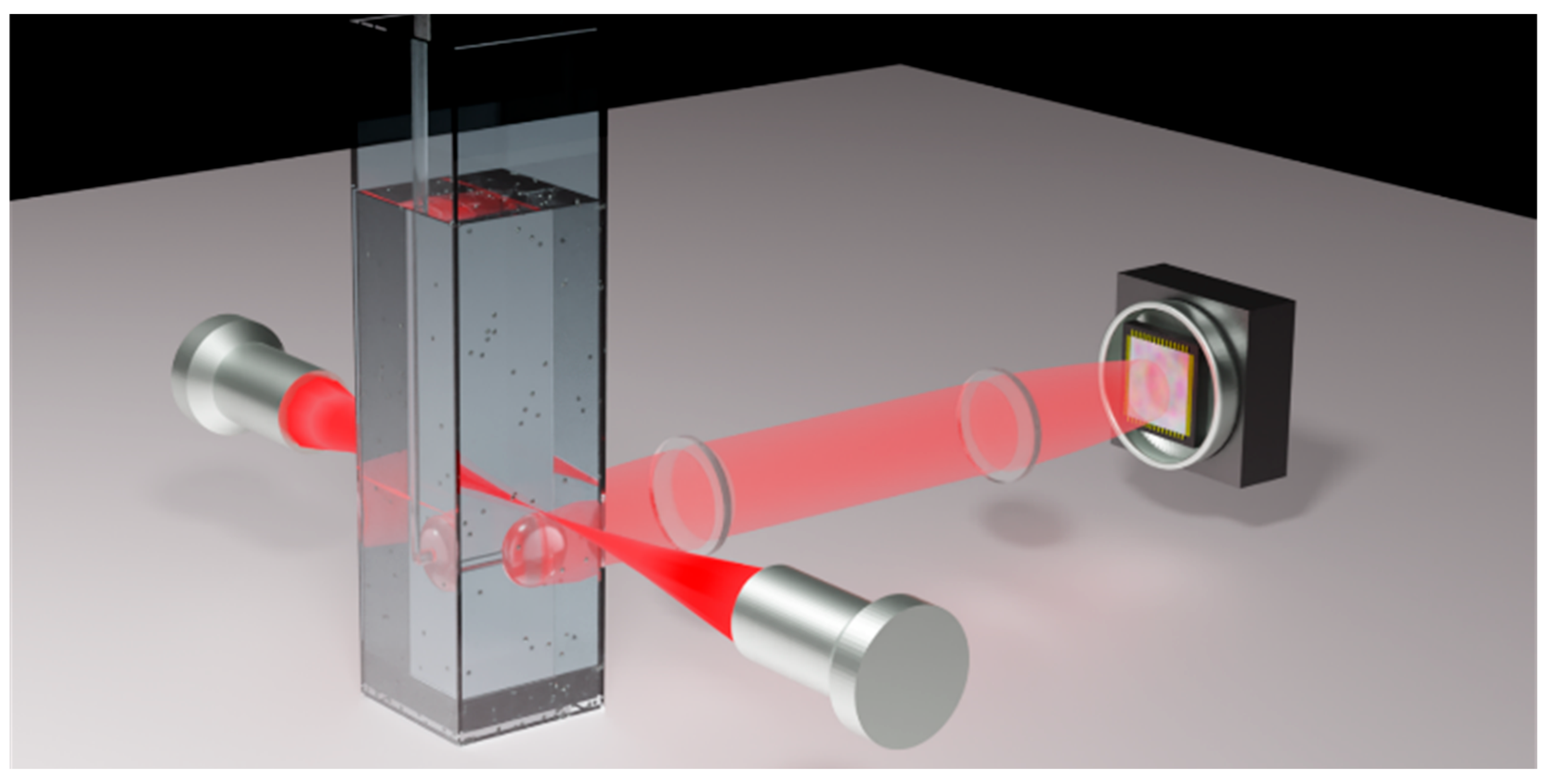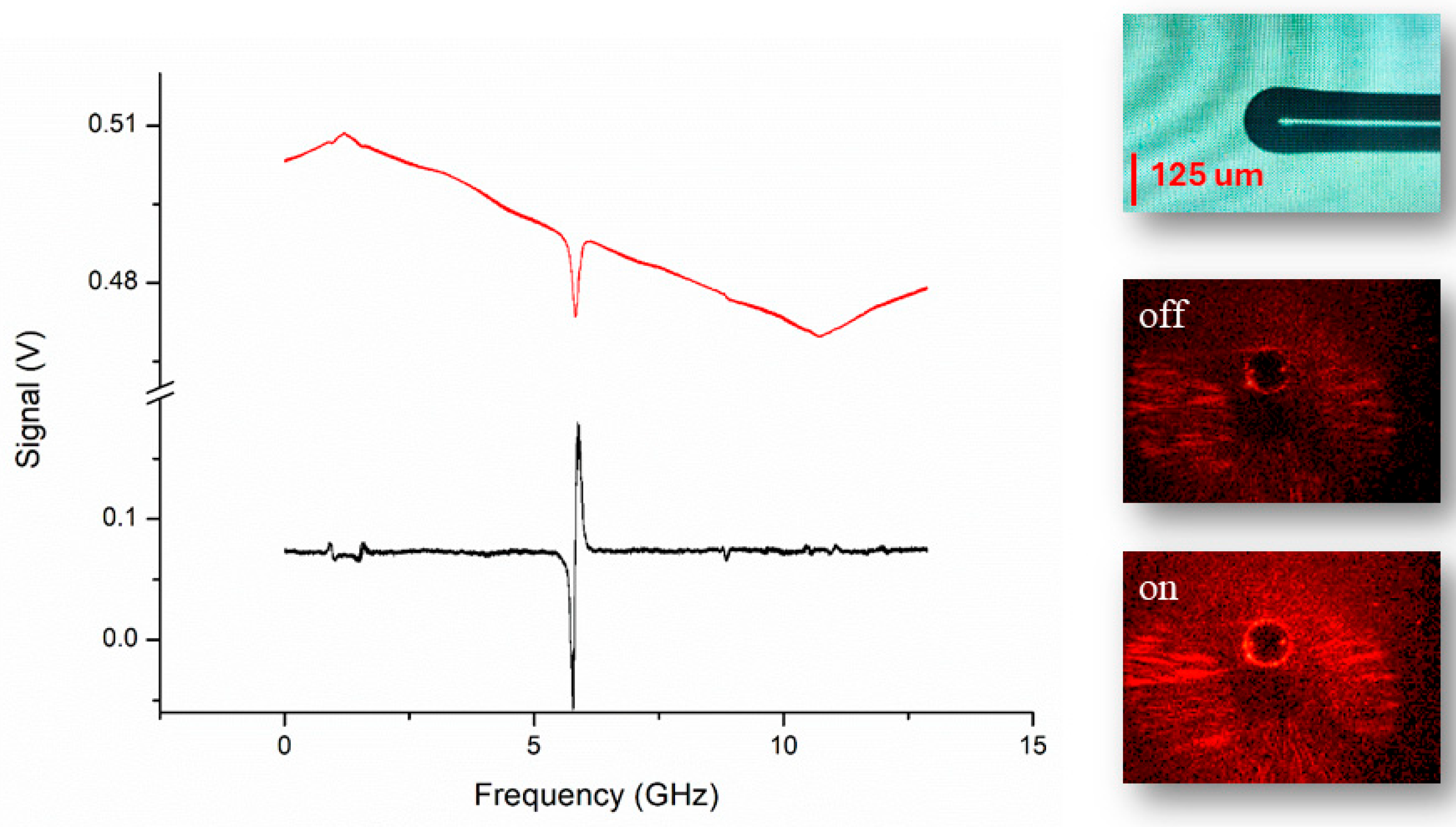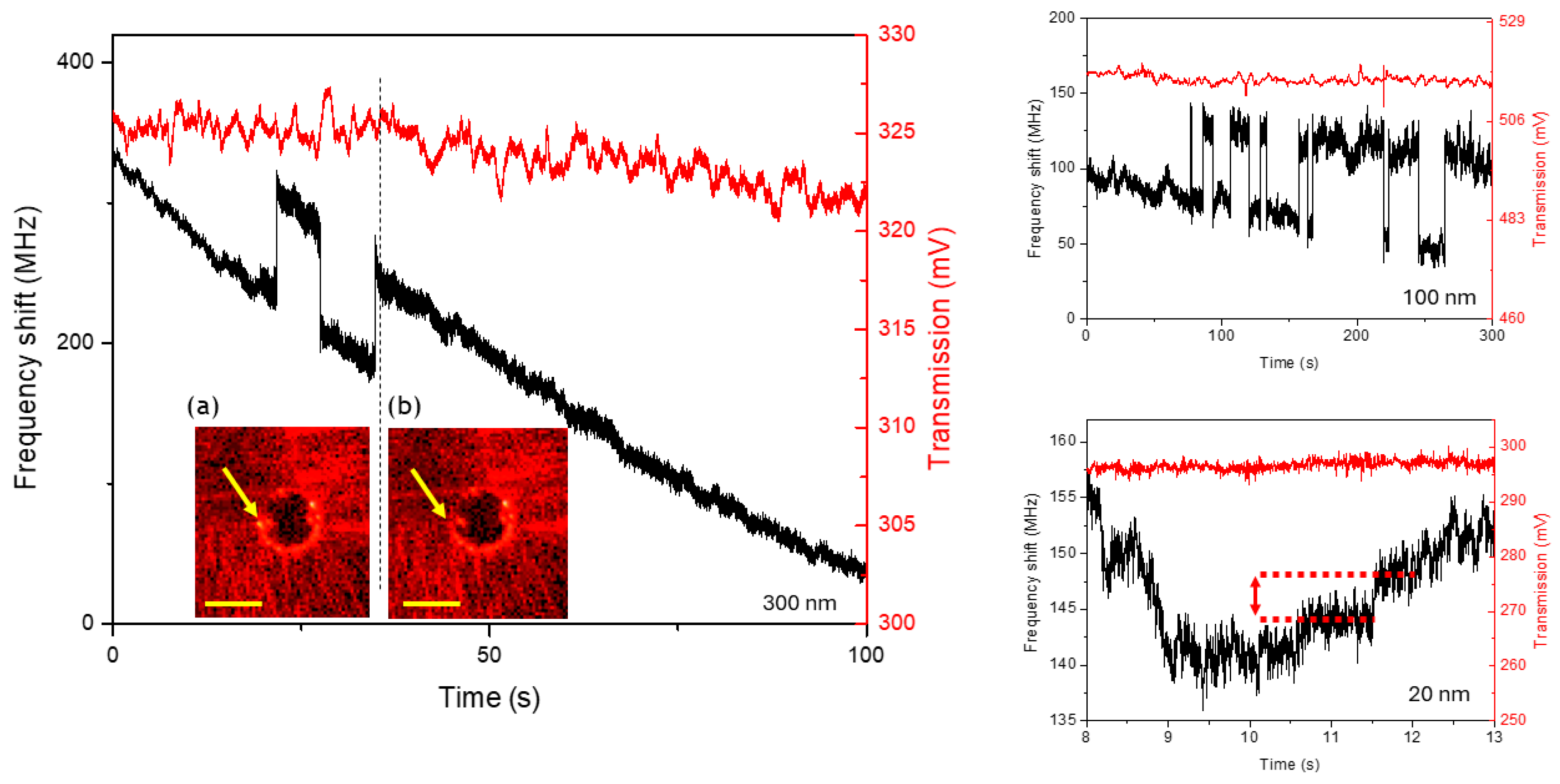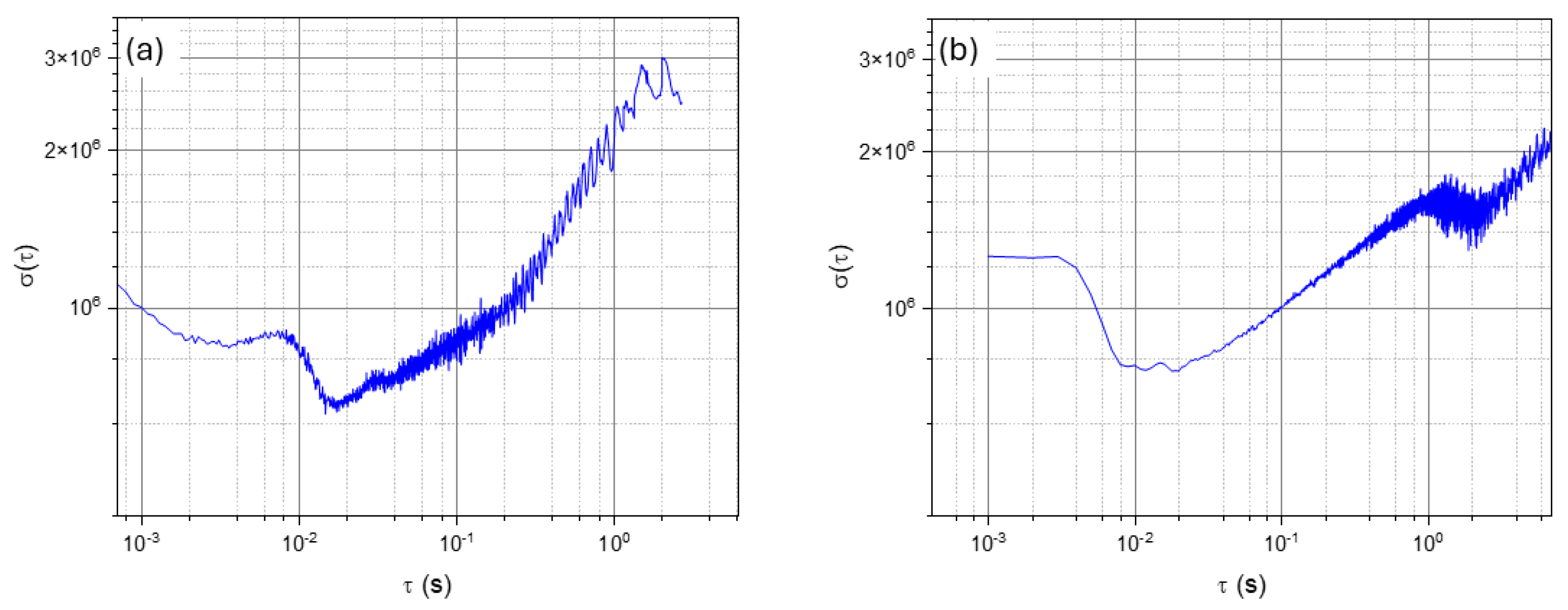Direct Nanoparticle Sensing in Liquids with Free-Space Excited Optical Whispering-Gallery-Mode Microresonators
Abstract
1. Introduction
2. Materials and Methods
3. Results
4. Conclusions
Author Contributions
Funding
Institutional Review Board Statement
Data Availability Statement
Acknowledgments
Conflicts of Interest
References
- Vollmer, F.; Arnold, S.; Keng, D. Single virus detection from the reactive shift of a whispering-gallery mode. Proc. Natl. Acad. Sci. USA 2008, 105, 20701–20704. [Google Scholar] [CrossRef] [PubMed]
- Barnes, J.A.; Gagliardi, G.; Loock, H. Absolute absorption cross-section measurement of a submonolayer film on a silica microresonator. Optica 2014, 1, 75. [Google Scholar] [CrossRef]
- Matsko, A.B.; Ilchenko, V.S. Optical resonators with whispering-gallery modes—Part I: Basics. IEEE J. Sel. Top. Quantum Electron. 2006, 12, 3. [Google Scholar] [CrossRef]
- Ilchenko, V.S.; Matsko, A.B. Optical resonators with whispering-gallery modes—Part II: Applications. IEEE J. Sel. Top. Quantum Electron. 2006, 12, 15. [Google Scholar] [CrossRef]
- Foreman, M.R.; Jin, W.-L.; Vollmer, F. Optimizing detection limits in whispering gallery mode biosensing. Opt. Express 2014, 22, 5491. [Google Scholar] [CrossRef] [PubMed]
- Knittel, J.; McRae, T.G.; Lee, K.H.; Bowen, W.P. Interferometric detection of mode splitting for whispering gallery mode biosensors. Appl. Phys. Lett. 2010, 97, 123704. [Google Scholar] [CrossRef]
- Dantham, V.R.; Holler, S.; Barbre, C.; Keng, D.; Kolchenko, V.; Arnold, S. Label-Free Detection of Single Protein Using a Nanoplasmonic-Photonic Hybrid Microcavity. Nano Lett. 2013, 13, 3347–3351. [Google Scholar] [CrossRef] [PubMed]
- Swaim, J.D.; Knittel, J.; Bowen, W.P. Detection of nanoparticles with a frequency locked whispering gallery mode microresonator. Appl. Phys. Lett. 2013, 102, 183106. [Google Scholar] [CrossRef]
- Lu, T.; Lee, H.; Chen, T.; Herchak, S.; Kim, J.-H.; Fraser, S.E.; Flagan, R.C.; Vahala, K. High sensitivity nanoparticle detection using optical microcavities. Proc. Natl. Acad. Sci. USA 2011, 108, 5976–5979. [Google Scholar] [CrossRef] [PubMed]
- Ghamari, S.; Chiarelli, G.; Kołątaj, K.; Subramanian, S.; Acuna, G.P.; Vollmer, F. Label-free (fluorescence-free) sensing of a single DNA molecule on DNA origami using a plasmon-enhanced WGM sensor. Nanophotonics 2025, 14, 253–262. [Google Scholar] [CrossRef] [PubMed]
- Foreman, M.R.; Swaim, J.D.; Vollmer, F. Whispering gallery mode sensors. Adv. Opt. Photonics 2015, 7, 168. [Google Scholar] [CrossRef] [PubMed]
- Chow, J.H.; Taylor, M.A.; Lam, T.T.; Knittel, J.; Sawtell-Rickson, J.D.; Shaddock, D.A.; Gray, M.B.; McClelland, D.E.; Bowen, W.P. Critical coupling control of a microresonator by laser amplitude modulation. Opt. Express 2012, 20, 12622. [Google Scholar] [CrossRef] [PubMed]
- Homola, J. Surface Plasmon Resonance Sensors for Detection of Chemical and Biological Species. Chem. Rev. 2008, 108, 462–493. [Google Scholar] [CrossRef] [PubMed]
- Heath, J.R.; Ribas, A.; Mischel, P.S. Single-cell analysis tools for drug discovery and development. Nat. Rev. Drug Discov. 2016, 15, 204–216. [Google Scholar] [CrossRef] [PubMed]
- D’Ambrosio, D.; Zambrana-Puyalto, X.; Capezzuto, M.; Giorgini, A.; Malara, P.; Avino, S.; Gagliardi, G. Angular-momentum coupling of optical whispering-gallery modes to liquid droplet microresonators. Phys. Rev. A 2021, 104, 043504. [Google Scholar] [CrossRef]
- Zambrana-Puyalto, X.; D’Ambrosio, D.; Gagliardi, G. Excitation Mechanisms of Whispering Gallery Modes with Direct Light Scattering. Laser Photonics Rev. 2021, 15, 2000528. [Google Scholar] [CrossRef]
- Toropov, N.; Cabello, G.; Serrano, M.P.; Gutha, R.R.; Rafti, M.; Vollmer, F. Review of biosensing with whispering-gallery mode lasers. Light Sci. Appl. 2021, 10, 42. [Google Scholar] [CrossRef] [PubMed]
- Maffeis, V.; Otter, A.; Düsterloh, A.; Kind, L.; Palivan, C.; Saxer, S.S. High-Throughput Silica Nanoparticle Detection for Quality Control of Complex Early Life Nutrition Food Matrices. ACS Omega 2024, 9, 17966–17976. [Google Scholar] [CrossRef] [PubMed]




| Nominal (nm) | 300 | 100 | 20 |
| Measured (nm) | 480 | 350 | 90 |
Disclaimer/Publisher’s Note: The statements, opinions and data contained in all publications are solely those of the individual author(s) and contributor(s) and not of MDPI and/or the editor(s). MDPI and/or the editor(s) disclaim responsibility for any injury to people or property resulting from any ideas, methods, instructions or products referred to in the content. |
© 2025 by the authors. Licensee MDPI, Basel, Switzerland. This article is an open access article distributed under the terms and conditions of the Creative Commons Attribution (CC BY) license (https://creativecommons.org/licenses/by/4.0/).
Share and Cite
D’Ambrosio, D.; Avino, S.; Gagliardi, G. Direct Nanoparticle Sensing in Liquids with Free-Space Excited Optical Whispering-Gallery-Mode Microresonators. Sensors 2025, 25, 5111. https://doi.org/10.3390/s25165111
D’Ambrosio D, Avino S, Gagliardi G. Direct Nanoparticle Sensing in Liquids with Free-Space Excited Optical Whispering-Gallery-Mode Microresonators. Sensors. 2025; 25(16):5111. https://doi.org/10.3390/s25165111
Chicago/Turabian StyleD’Ambrosio, Davide, Saverio Avino, and Gianluca Gagliardi. 2025. "Direct Nanoparticle Sensing in Liquids with Free-Space Excited Optical Whispering-Gallery-Mode Microresonators" Sensors 25, no. 16: 5111. https://doi.org/10.3390/s25165111
APA StyleD’Ambrosio, D., Avino, S., & Gagliardi, G. (2025). Direct Nanoparticle Sensing in Liquids with Free-Space Excited Optical Whispering-Gallery-Mode Microresonators. Sensors, 25(16), 5111. https://doi.org/10.3390/s25165111









